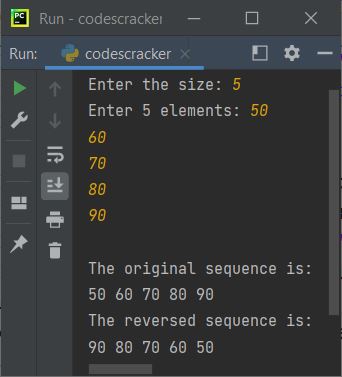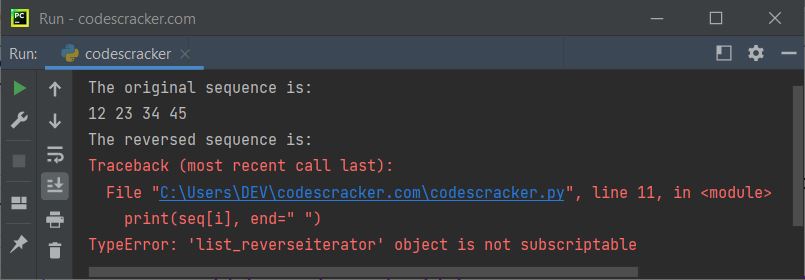- Python Built-in Functions
- Python All Built-in Functions
- Python print() Function
- Python input() Function
- Python int() Function
- Python float() Function
- Python len() Function
- Python range() Function
- Python str() Function
- Python ord() Function
- Python chr() Function
- Python ascii() Function
- Python pow() Function
- Python type() Function
- Python List Functions
- Python list() Function
- Python insert() Function
- Python append() Function
- Python extend() Function
- Python pop() Function
- Python remove() Function
- Python reverse() Function
- Python sort() Function
- Python sorted() Function
- Python Dictionary Functions
- Python dict() Function
- Python update() Function
- Python get() Function
- Python keys() Function
- Python setdefault() Function
- Python fromkeys() Function
- Python items() Function
- Python popitem() Function
- Python Tuple Function
- Python tuple() Function
- Python Set Functions
- Python set() Function
- Python frozenset() Function
- Python String Functions
- Python split() Function
- Python join() Function
- Python format() Function
- Python replace() Function
- Python Iterator Functions
- Python iter() Function
- Python min() Function
- Python max() Function
- Python sum() Function
- Python count() Function
- Python index() Function
- Python copy() Function
- Python clear() Function
- Python next() Function
- Python filter() Function
- Python enumerate() Function
- Python zip() Function
- Python reversed() Function
- Python Number Functions
- Python abs() Function
- Python bin() Function
- Python oct() Function
- Python hex() Function
- Python round() Function
- Python divmod() Function
- Python complex() Function
- Python File Handling Functions
- Python open() Function
- Python read() Function
- Python readable() Function
- Python readline() Function
- Python readlines() Function
- Python write() Function
- Python writable() Function
- Python writelines() Function
- Python close() Function
- Python seek() Function
- Python tell() Function
- Python flush() Function
- Python fileno() Function
- Python truncate() Function
- Python Class Functions
- Python object() Function
- Python property() Function
- Python getattr() Function
- Python setattr() Function
- Python hasattr() Function
- Python delattr() Function
- Python classmethod() Function
- Python staticmethod() Function
- Python issubclass() Function
- Python super() Function
- Python Misc Functions
- Python all() Function
- Python any() Function
- Python isatty() Function
- Python bool() Function
- Python callable() Function
- Python globals() Function
- Python locals() Function
- Python dir() Function
- Python id() Function
- Python isinstance() Function
- Python map() Function
- Python repr() Function
- Python slice() Function
- Python vars() Function
- Python Advance Functions
- Python help() Function
- Python hash() Function
- Python breakpoint() Function
- Python bytes() Function
- Python bytearray() Function
- Python memoryview() Function
- Python compile() Function
- Python eval() Function
- Python exec() Function
- Python Tutorial
- Python Tutorial
- Python Examples
- Python Examples
Python reversed() Function
The reversed() function in Python returns the reversed iterator object or the iterator of a given sequence such as list, tuple, string etc. For example:
a = [32, 34, 56, 76] b = reversed(a) for x in b: print(x, end=" ")
Following is the output produced by this Python program, demonstrating the reversed() function:
76 56 34 32
Python reversed() Function Syntax
The syntax of reversed() function is:
reversed(sequence)
Python reversed() Function Example
Here is an example example that uses the reversed() function to get the reverse iterator of a sequence:
print("Enter the size: ", end="") n = int(input()) print("Enter", n, "elements: ", end="") seq = [] for i in range(n): val = input() seq.append(val) print("\nThe original sequence is:") for x in seq: print(x, end=" ") seq = reversed(seq) print("\nThe reversed sequence is:") for x in seq: print(x, end=" ")
The snapshot given below shows the sample run of above program, with user input 5 as size, and 50, 60, 70, 80, 90 as five numbers for the sequence:

Important - The list_reverseiterator object is not subscriptable. Therefore, we can not access the element through indexing. If we do so, like shown in the program given below:
seq = [12, 23, 34, 45] n = 4 print("The original sequence is:") for i in range(n): print(seq[i], end=" ") seq = reversed(seq) print("\nThe reversed sequence is:") for i in range(n): print(seq[i], end=" ")
Then it will raised the error like shown in the snapshot given below. This snapshot is taken from the output produced by above program:

Therefore we need to replace the following block of code from above program:
for i in range(n): print(seq[i], end=" ")
with the block of code given below:
for x in seq: print(x, end=" ")
If you create a program like:
seq = [12, 23, 34, 45] print(reversed(seq))
then the output you'll see, looks similar to:
<list_reverseiterator object at 0x000001E89AF18040>
which is not the output that we need. Because we need the same sequence, but in reverse. Therefore we need to wrap the reversed() inside a list. Here is the modified version of previous program:
seq = [12, 23, 34, 45] print(list(reversed(seq)))
Now the output would be:
[45, 34, 23, 12]
Here is another example uses reversed() function to get the reversed iterator object of a sequence.
mystring = "codescracker" print(list(reversed(mystring))) mylist = [1, 2, 3] print(list(reversed(mylist))) mytuple = (4, 5, 6) print(list(reversed(mytuple))) myrange = range(10) print(list(reversed(myrange)))
The output produced by this program will exactly be:
['r', 'e', 'k', 'c', 'a', 'r, 'c', 's', 'e', 'd', 'o', 'c'] [3, 2, 1] [6, 5, 4] [9, 8, 7, 6, 5, 4, 3, 2, 1, 0]
« Previous Function Next Function »